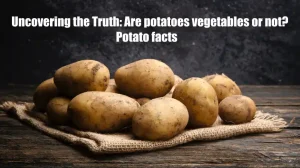Potatoes are a staple food grown in space in many households and are often a topic of debate in the culinary and nutrition world. One of the most significant ambiguities surrounding potatoes is whether they can be classified as vegetables or not. Please read through our article to find out the potato facts.

Types of Potatoes
Exploring the world of potatoes reveals different varieties of potatoes, each with unique qualities and uses. Understanding the different potato types is essential for culinary enthusiasts and individuals seeking to maximize the nutritional benefits of these starchy tubers.
From russet to sweet potatoes, the array of potato varieties is extensive, with each type offering distinct flavors, textures, and culinary applications. Whether mashing, baking, or frying, knowing the characteristics of various potato types can elevate any dish.
Classification: Is a potato a vegetable or fruit?
Potatoes are categorized as a carbohydrate instead of a fruit because they are starch content, not sugar, through cellular respiration. A nutritional expert from Harvard School argued that potatoes should be considered fruits since they grow underground and develop into edible tuberous roots. He believes the distinction between the two lies in the growth stage of each crop.
Tubers like potatoes are removed from the ground before fully grown and continue to grow under the ground. When released and come into contact with the air, their skin changes color and produces starch, similar to corn. In contrast, an average apple ripens above the ground and loses its nutritional value soon after being harvested. Therefore, potatoes are classified as fruits since they maintain their nutritional value longer than apples.
Apart from the debate over whether potatoes belong to the fruit or vegetable category, botanists need help to reach a consensus on their classification. Nevertheless, the similarities between potatoes and other tubers like cassava and taro justify their inclusion in the same category. Additionally, potatoes can be further categorized into four main groups: Russet Burbank, Norland, German Blue Strain, and Atlantic. Each group contains varying levels of nutrients and minerals, which adds to the debate on whether they should be classified as first vegetable or fruit. Despite the ongoing discussion, it is clear that potatoes belong somewhere in the middle.
Potato Museum and Cultural Significance
Potatoes have played a crucial role in the culinary and cultural landscapes of various societies across the globe. In some cultures, potatoes are considered a dietary staple; in others, they are an integral part of traditional cuisines. The significance of potatoes extends beyond mere sustenance, as they have become embedded in the cultural fabric of societies, often symbolizing comfort and nourishment.
The Role of Potatoes in Different Cultures
Their versatility and adaptability make them a valuable resource in areas where other crops may struggle to thrive, thus playing a pivotal role in ensuring food security in many communities. Potatoes have been embraced in diverse ways across different cultures. In some regions, such as South America and parts of Europe, potatoes are a dietary mainstay, prominently featured in traditional dishes and celebrations.
Idaho, situated in the northwestern region of the United States, is one of the states in the country. A specific name is known for each state in the US; Idaho carries the nickname of The Potato State because they are one of the largest potato producers.
The Potato’s Journey from the Andes to Your Plate
The captivating journey of potatoes from their origin in the Andes to becoming a ubiquitous feature in global cuisines is a testament to human ingenuity and agricultural innovation. The widespread cultivation and consumption of potatoes have transformed them into a culinary cornerstone, offering sustenance and nourishment to people worldwide. Their journey symbolizes the interconnectedness of cultures and the enduring impact of food on human history.

Potato Nutrition and Health Benefits
Potatoes provide a wealth of essential nutrients and health benefits, debunking misconceptions about their nutritional value. Aside from being considered a starchy vegetable, potatoes are good sources of vitamin C, potassium, and other vital nutrients contributing to overall well-being.
Understanding the Nutritional Value of Potatoes
Exploring the nutritional profile of potatoes reveals their potential to support a healthy diet. Their high potassium content maintains healthy blood pressure levels and promotes proper nerve and muscle function. Moreover, vitamin C in potatoes enhances immune function and supports healthy skin and tissue repair, underscoring their importance in a balanced diet. Potato skin is often overlooked, but it’s safe and contains additional nutrients, promoting digestive health and providing antioxidants.
Common Misconceptions About Potatoes
Despite their nutritional value, potatoes have been subject to misconceptions, undermining their health benefits. One prevalent myth is that potatoes are inherently unhealthy due to their association with high-calorie preparations such as French fries. However, when prepared and consumed balanced, potatoes can be part of a nutritious and well-rounded diet. Understanding the nuanced role of potatoes in our dietary choices is essential for dispelling myths and reaping their nutritional advantages.
Healthy Potato Recipes
Potatoes are incredibly versatile and can be the foundation of numerous healthy and delicious dishes. Incorporating them into nutritious recipes is a great way to enjoy their unique flavor while reaping their health benefits. From potato chips, potato salads to a comforting bowl of mashed potatoes and leek potato soup, there are countless ways to make potatoes get to be a part of a wholesome meal plan.
Tips for Maximizing the Nutritional Value of Potatoes
To maximize the nutritional value of potatoes, consider not peeling the skin when cooking. The potato skin contains a rich source of fiber and essential nutrients, such as potassium and antioxidants. Additionally, opt for healthier cooking methods, such as baking or boiling, instead of frying – which makes potatoes unhealthy, to retain the nutritional integrity of the potatoes. Pairing potatoes with other nutrient-rich foods, such as leafy greens or lean protein, can further enhance their overall dietary contribution to a meal.
Unsafe ways to consume potatoes
There are things can’t go with potatoes. Among which, potatoes and bananas should not go together. Both of them are high in carbs, when eaten together, they create a chemical reaction that increases the amount of sugar and starch absorbed into the body.
Another thing that needs to be aware is sprouted potatoes that contain elevated levels of glycoalkaloids. It can be harmful to humans if consumed excessively. It can lead to food poisoning and potentially even result in death.
Conclusion
In conclusion, starchy potatoes are undoubtedly a valuable addition to a healthy and balanced diet. Despite their nature, their nutrient content and versatility make them a beneficial component of various culinary creations. Individuals can harness their nutritional benefits while indulging in different flavorful and wholesome dishes by understanding the diverse ways to prepare and enjoy potatoes.
